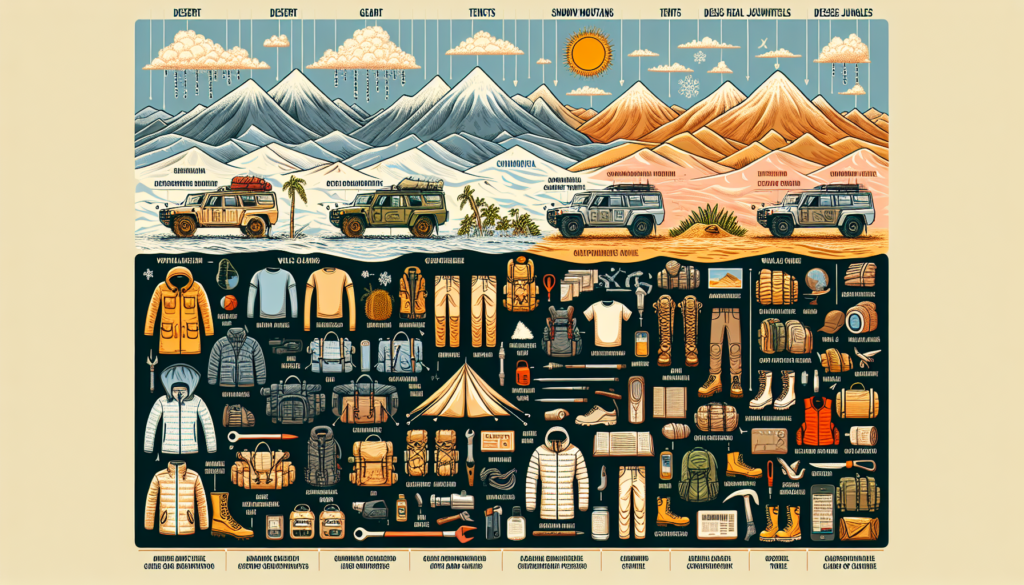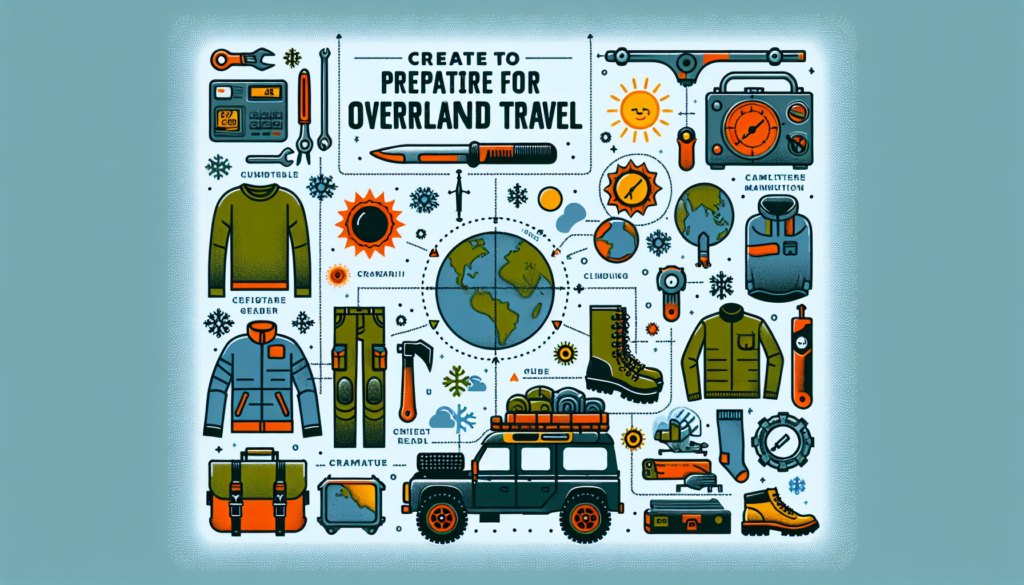Are you ready to embark on an exciting adventure of overland travel? From the sun-soaked deserts to snow-capped mountains, exploring different climates can be both exhilarating and challenging. But fear not, because in this article, we’ll provide you with all the information you need to prepare for your journey. Whether you’re facing scorching heat or icy cold, we’ve got you covered with essential tips and tricks that will ensure your comfort and safety throughout your expedition. So get ready to pack your bags, because we’re about to take you on a whirlwind tour of how to navigate through different climates during your overland travels.

Choosing the Right Vehicle
When it comes to overland travel, choosing the right vehicle is crucial. Consider climate variations that you may encounter during your journey. Different vehicles have varying levels of insulation, ventilation, and heating capabilities, which can greatly impact your comfort and safety. Evaluate the terrain you will be traversing as well – will you be tackling steep inclines, rough off-road trails, or mostly paved roads? Assessing the capabilities of your vehicle is essential to ensure it can handle the demands of your chosen route. Moreover, ensure that your vehicle has sufficient cargo space to accommodate all the gear and supplies you will need for your journey.
Researching Climate and Weather Patterns
One of the key aspects of preparing for overland travel is researching and understanding the climate and weather patterns of the regions you plan to visit. Understanding seasonal changes will help you pack the appropriate gear for each season. Study temperature variations to ensure you have the proper clothing and equipment to stay comfortable in both hot and cold conditions. Analyze precipitation patterns to anticipate rain or snow and be prepared with the necessary gear. Additionally, review humidity levels to determine if you need to take extra precautions to combat moisture-related issues.
Assembling the Essential Gear
Before embarking on your overland travel adventure, it is essential to assemble the essential gear that will ensure your comfort, safety, and convenience on the road. Clothing and apparel should be chosen based on the climate you will encounter – pack items that can be layered for variable temperatures, choose moisture-wicking fabrics to keep you dry, and consider waterproof and windproof materials for protection against the elements. Your sleeping gear and shelter should provide adequate insulation and protection, while your cooking equipment and utensils should be lightweight and functional. Don’t forget to pack emergency supplies and a well-stocked first aid kit to handle unforeseen situations.
Packing Appropriate Clothing
When it comes to packing clothing for overland travel, it is crucial to consider the various climates you may encounter along your journey. Layering is a key strategy for dealing with variable temperatures. Pack a combination of base layers, mid-layers, and outer layers that can be easily added or removed to adapt to changing weather conditions. Choosing moisture-wicking fabrics will help keep you comfortable, as they draw sweat away from your body, allowing it to evaporate more easily. Additionally, considering waterproof and windproof materials will protect you from rain and gusts of wind, keeping you dry and warm.

Preparing for Extreme Cold
If your overland journey takes you through regions with extreme cold temperatures, proper preparation is crucial to ensure your comfort and safety. Insulation techniques for your vehicle, such as adding extra insulation to the walls and windows or using thermal curtains, can help retain heat inside. Investing in proper winter apparel, such as insulated jackets, thermal underwear, and warm boots, will keep you warm when venturing outside. Packing extra blankets and sleeping bags will provide additional warmth during cold nights. It is better to be over-prepared for extreme cold conditions than to risk discomfort or frostbite.
Surviving in Hot and Arid Climates
Hot and arid climates can pose unique challenges during overland travel, and it is important to be adequately prepared. Ensuring an adequate water supply is essential to prevent dehydration, so carry enough water for both drinking and other uses. Protecting yourself from the sun is crucial, so pack sunscreen with a high SPF, sunglasses, and a wide-brimmed hat. Utilize shade whenever possible and ensure your vehicle has proper ventilation to prevent overheating. Finally, educate yourself about heat-related illnesses and take necessary precautions to prevent them, such as staying hydrated and taking breaks in cooler environments.
Navigating Wet and Humid Environments
For overland travel in wet and humid environments, waterproofing your vehicle and gear is essential. Ensure all windows and doors are properly sealed and consider adding additional waterproofing measures to your vehicle, such as applying a protective coating to its exterior. Select clothing made from quick-drying materials to avoid discomfort from prolonged exposure to moisture. Using moisture-absorbing products, such as desiccant packets or moisture-absorbing bags, can help keep your gear dry and prevent mold or mildew growth. Regularly air out your gear and clean it to minimize the risk of moisture-related issues.
Dealing with High Altitude Challenges
Overland travel in high-altitude areas presents its own unique set of challenges, primarily related to the impact of altitude on your body. Understanding altitude sickness and its symptoms is crucial for recognizing and managing this condition effectively. Gradual acclimatization techniques, such as slowly ascending to higher altitudes, can help your body adjust to the changes in air pressure. Proper nutrition and hydration at altitude are also important – consuming a balanced diet and increasing your fluid intake can help mitigate altitude-related symptoms. Plan your journey accordingly and give yourself enough time to acclimate properly.
Maintaining the Vehicle
Proper maintenance of your vehicle is essential for a successful and hassle-free overland travel experience. Regularly check fluid levels, such as oil, coolant, and brake fluid, to ensure optimal vehicle performance. Inspect mechanical components, including brakes, tires, and suspension, to ensure they are in good working condition. Carrying spare parts and tools specific to your vehicle’s make and model is important to address any unforeseen breakdowns or repairs. Additionally, conducting regular vehicle inspections, both before and during your journey, will help identify and address any issues before they become significant problems.
Respecting Local Customs and Regulations
A crucial aspect of overland travel is respecting the local customs and regulations of the regions you visit. Research local laws and regulations to ensure you are aware of any restrictions or requirements regarding driving, camping, and interacting with local communities. Adapting to cultural norms is essential for fostering positive interactions and avoiding misunderstandings. Respect environmental conservation efforts by disposing of waste properly, minimizing your impact on natural resources, and adhering to any designated protected areas or wildlife sanctuaries. Consider engaging with local communities in a respectful and responsible manner, leaving a positive impression as you explore new territories.
By following these guidelines and thoroughly preparing for overland travel in different climates, you will be well-equipped to handle the challenges that come your way. Remember to research, plan, and pack accordingly, ensuring your journey is comfortable, safe, and enjoyable. Happy travels!

